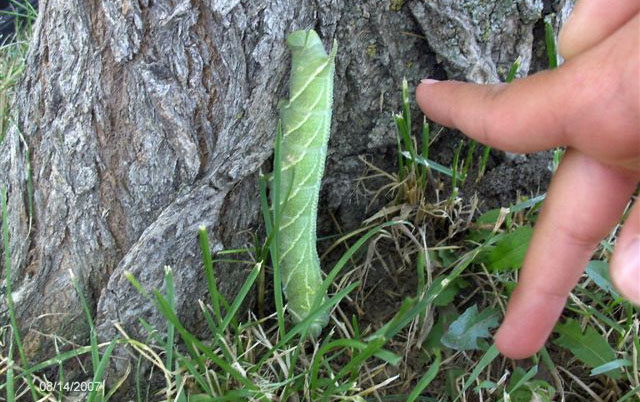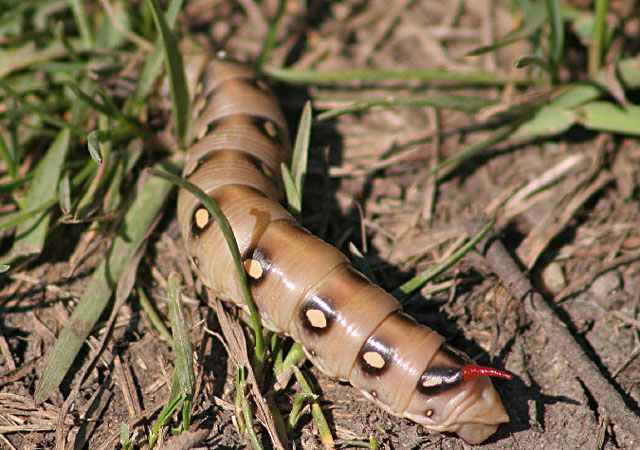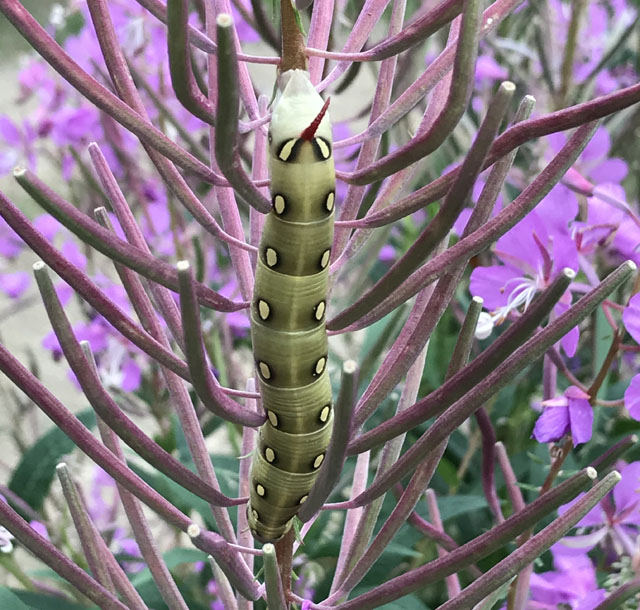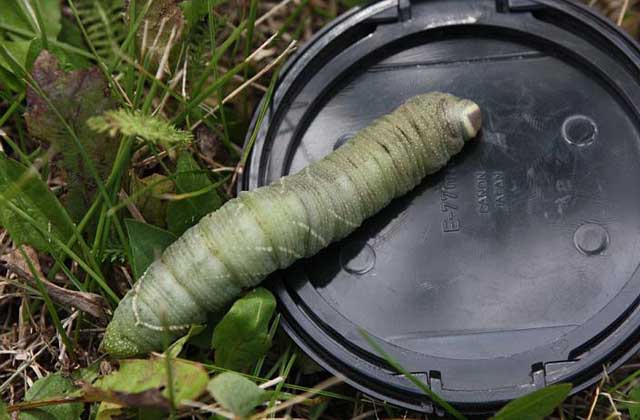Sphinginae subfamily
Sphingini tribe:
 |
Ceratomia amyntor
SB,
the Elm Sphinx or Four-horned Sphinx:
Larvae feed on Elm (Ulmus), birch (Betula), basswood
(Tilia), and cherry (Prunus).
There are both green and brown forms. The four horns near
the head are diagnostic. |
Ceratomia amyntor larva, Drumhellar, courtesy of Burt and Shirley Krull via Sue Brooks.
 |
Ceratomia undulosa
ALG/EU, the Waved
Sphinx:
Fraxinus, Ligustrum, Quercus, Crataegus and
Chionanthus virginicus are listed as hosts.
In the fifth instar, the spiracular ovals are decidedly red and the
anal horn is off-white to pinkish laterally.
|
Ceratomia undulosa adult moth, Edmonton, summer 2004, courtesy of Evie Uretsky

| Lapara bombycoides
ALG, the Northern Pine Sphinx:
This caterpillar is also without the anal horn and feeds on pines.
The long stripes and reddish brown afford great camouflage.
|
 |
Sphinx chersis
ALG/GH, the Northern Ash Sphinx or Great Ash
Sphinx:
The larvae are pale bluish green. The head has a pair of yellow
lateral bands meeting at the apex. The oblique, lateral stripes are
pale and bordered anteriorly with a darker green.
Larval hosts are ash, lilac, privet, cherry, and quaking aspen.
|
Sphinx chersis, July 6, 2008, Calgary, Glenna Hauck
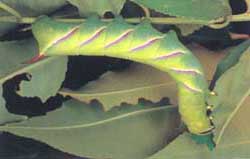 |
Sphinx drupiferarum ALG, the Wild Cherry Sphinx:
Sphinx drupiferarum larvae hide in the day and feed primarily on
cherry, plum, and apple at night. Larvae have been found on Amelanchier nantuckensis in Massachusetts and have been reared to pupation in Michigan on
Prunus serotina from eggs readily oviposited by a female. |
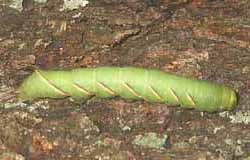 |
Sphinx luscitiosa ALG,
Canadian Sphinx or Clemen's Sphinx. Larval hosts are willow (Salix), poplar (Populus), birch (Betula),
apple (Malus), ash (Fraxinus), waxmyrtle (Morella), and northern bayberry. |
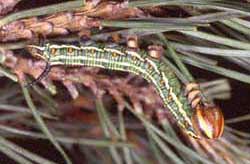 |
Sphinx pinastri , ALG, Pine Hawkmoth:
Larvae feed on various species of conifers, including Scotch pine (Pinus sylvestris); and spruce, including Norway spruce
(Picea abies). Larvae ocur in green form (depicted left) and dark form. rare |
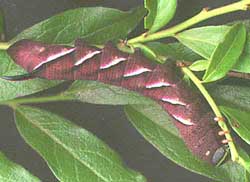 |
Sphinx poecila ALG, the Poecila Sphinx:
If you have blueberries in the woods, then you probably have the Poecila Sphinx. There are both a green form and a purple form. |
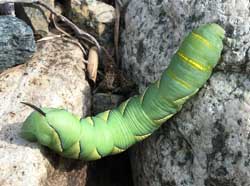 |
Sphinx vashti ALG,
the Snowberry Sphinx: Larvae feed on the common snowberry (Symphoricarpos albus)
and on coralberry (S. orbiculatus). Note the two golden linesof slightly raised bumps, one just behind the head, the other on the
thorax. |
Smerinthini Tribe:
 |
Pachysphinx modesta ALG/DH,
the Modest Sphinx or Poplar Sphinx: Larvae feed on poplars and cottonwood. The anal horn is very rudimentary in the final instar.
|
Pachysphinx modesta prepupal, Vegreville, August 24, 2008, courtesy of David Hibbeln.
 |
Larvae accept willows, birches, and cherries.
I have also found them in the wild on oak in eastern Canada.
generally more eastern species
|
 |
Paonias myops ALG, the Small-eyed Sphinx:
Wild cherry species are the favorites as larval foodplants, but eggs
will also be deposited on birches and other forest trees.
There are varying degrees in the amount of red markings along the sides.
|
 |
Smerinthus cerisyi ALG, Cerisy's Sphinx; Greatly resemble modesta larvae, pale green, granular skin,
pale lateral diagonal lines, faint red spiracular circles, very pale longitudinal lines running from head to more pronounced anal diagonal line. Larvae have
green heads bounded dorsally with pale yellow inverted "V".
|
 |
Smerinthus jamaicensis ALG,
the Twin-spotted Sphinx: Larvae feed upon many forest trees including birches and cherries,
but are expecially fond of poplars and willows. Red markings on sides
vary greatly from specimen to specimen.
|
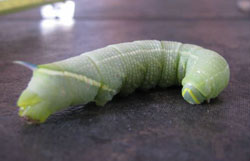 |
Smerinthus ophthalmica WO:
Resemble cerisyi larvae, pale green, granular skin, pale lateral diagonal lines, faint red
spiracular circles, very pale longitudinal lines running from head to more pronounced anal diagonal line.
Green heads bounded dorsally with pale yellow inverted V. Blue horn.
|
Macroglossinae subfamily
Dilophonotini Tribe:
See Hemaris comparison to help distinguish
the next three species.
 |
Hemaris diffinis ALG/RB,
Snowberry Clearwing; Bumblebee Moth:
Snowberry (Symphoricarpos),
honeysuckle (Lonicera), Coralberry, viburnums, Blue Dogbane
(Apocynum), dwarf bush honeysuckle (Diervilla lonicera).
Horn black, yellow base. East of Continental Divide.
|
Hemaris diffinis prepupal larva, near Gull Lake, August 14, 2011, Robert Bercha.
 |
Hemaris gracilis
ALG, the
Slender Clearwing or Graceful Clearwing
Larval foods are blueberries including low bush blueberry
(Vaccinium vacillans), and laurel (Kalmia), all in the
heath family (Ericaceae).
|
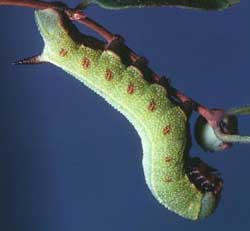 |
Larval host plants include Snowberry (Symphoricarpos),
honeysuckle (Lonicera), Coralberry, viburnums, high bush cranberry and hawthorn (Crataegus).
Horn is black with a slightly lighter base. This western species was formerly classified as
H. diffinis or H. senta. Those species west of the Continental Divide are now classified as
H. thetis.
|
 |
Hemaris thysbe
ALG/SB, the Hummingbird Clearwing
There is also an orangey-pink prepupal form. The lateral line runs
from S1 to the blue horn.
Hemaris thysbe larvae feed on viburnum and related plants.
generally more eastern species
|
Hemaris thysbe, 27 km north of Lave Lake, June 13, 2009, Shawn Baker.
Macroglossini Tribe:
 |
In additon to Virginia creeper larvae accept Grape (Vitis),
ampelopsis (Ampelopsis), and cayenne pepper (Capsicum).
Larvae are green until the final instar.
|
 |
Larvae feed on Azalea and Viburnum and progress very rapidly. The
larva to the left on Viburnum cassinoides is getting ready to
pupate. Color change from green to light burgundy-brown indicates
pupation is imminent. |
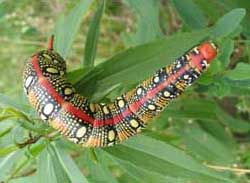 |
Hyles euphorbiae ALG/bmb/DH/JW, Spurge Hawk Moth:
Young larvae are variously patterned with green, yellow, and black; older larvae have a distinctive red, black, yellow, and white
color pattern. Mature larvae may approach 10 cm in length; when disturbed, they regurgitate a slimy green liquid.
Larvae feed on leafy spurge. |
Hyles euphorbiae larva, Calgary, Alberta, July 27, 2012, Don Hladky.
Hyles euphorbiae, near Lethbridge, Alberta, August 2, 2012, Justine Willis
Hyles euphorbiae, near Rundle Park, Edmonton, Alberta, July 25, 2014, Telofson
 |
Hyles gallii
ALG/JB/BAS, the Bedstraw Hawk Moth
or Gallium Sphinx
Larvae come in black, in brown and in forms (see bottom of page) and often feed on
Epilobium (fireweed). There is also variation in the colour of the larger subdorsal spots.
|
Hyles gallii, fifth instar, Edmonton, July 2006, Joanne Bovee
Hyles gallii, fifth instar, Sibbald Flats, Kananaskis Co., August 31, 2011, Betty Ann Swaim
 |
Hyles lineata
ALG/HH, the White-lined Sphinx:
Larvae are highly varied and feed on a great diversity of plants
including willow weed (Epilobium), four o'clock (Mirabilis),
apple (Malus), evening primrose (Oenothera), elm
(Ulmus), grape (Vitis), tomato (Lycopersicon),
purslane (Portulaca), and Fuschia.
All larvae seem, however, to have the red/black swellings split by
dorso-lateral lines. |
Hyles lineata, adult moth, Vermilion, August 12, 2007, courtesy of Holly Holmen.
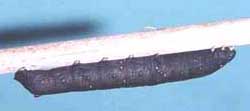 |
Proserpinus flavofasciata
ALG, Yellow-banded Day Sphinx. Penultimate instar: pale green with pair of pale,
dorsolateral lines running from head to base of short caudal horn. Final instar: brown-black with numerous black dots; caudal horn
replaced by black button surrounded by white ring edged with black. |
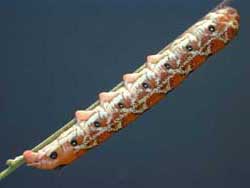 |
Proserpinus juanita ALG, the Juanita Sphinx:
Newly-hatched caterpillars eat their eggshells. Larvae feed on (Onagraceae) including evening primrose (Oenothera), gaura (Gaura),
and willow weed (Epilobium). Michael Van Buskirk has found them on Guara biennis in Missouri.
|
|
|
